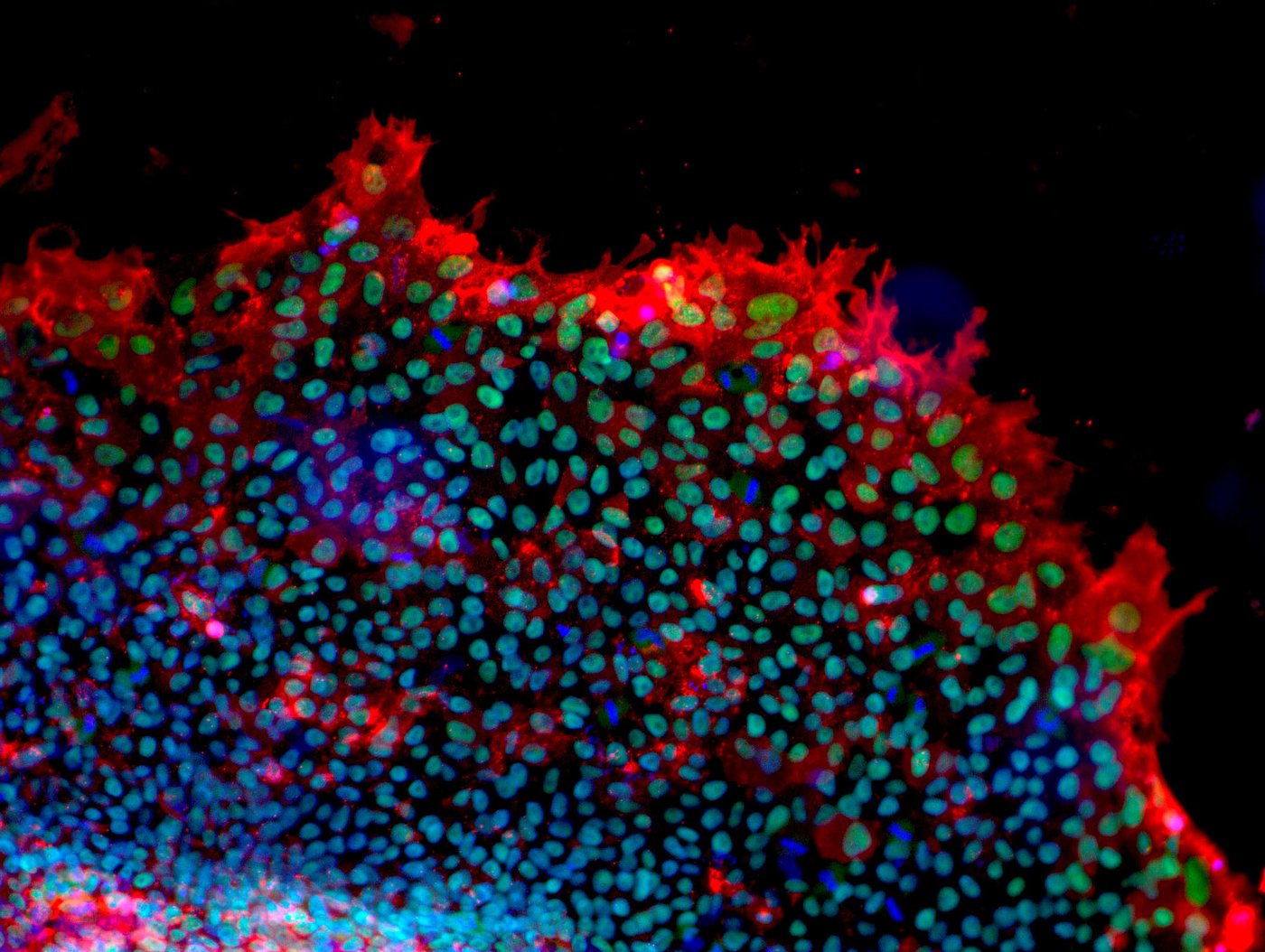
Human mesenchymal stromal cells from adipose tissue - The cells were differentiated into fat cells and fat droplets were stained green. Cell nuclei were stained blue. [Copyright: Institute for Biomedical Engineering – Cell Biology, UK Aachen]
Stem cells are highly fascinating for science and offer great potential for research into serious diseases that do not yet have a cure. Many research projects work in parallel with adult, embryonic, and induced pluripotent stem cells. The goals of stem cell research are manifold and can currently be described in the following categories:
Basic research focuses on elucidating the molecular mechanisms behind the specialization of individual cells as well as investigating the organization of cells in tissue structures and organs. In addition, the aim is to gain a better understanding of the development and regulation of early stem cell stages and to investigate the mechanisms underlying the ability to proliferate and differentiate.
ES cells, in particular, can provide valuable insights into embryonic development. The main goal is to understand the mechanisms and molecular bases that lead to the specialization of a totipotent fertilized egg or a very early embryo. In addition, ES cells make it possible to better understand malformations and diseases and to prevent them in the long term.
Many serious and so far incurable diseases are associated with the loss of cells that the body cannot regenerate naturally. Examples include neurological diseases such as Alzheimer’s and Parkinson’s, as well as diabetes, paraplegia and heart attacks. The basic idea behind cell replacement therapy is to replace or repair the lost tissue with the help of stem cells. Scientists worldwide are researching the development of such cell replacement therapies. Tissue replacement is particularly interesting for those tissues that have little or no regenerative capacity, such as nerve tissue. However, most therapies, e.g. for the treatment of diabetes or Parkinson’s disease, are still in (pre-)clinical research. The transplantation of bone marrow stem cells, skin stem cells, and corneal stem cells in the eye iscurrently permitted.
The approaches researchers in Germany are working on are either based on the use of adult stem cells or iPS cells. In some countries, cell replacement therapies using embryonic stem cells are also being developed, but this is not permitted in Germany.
In the meantime, the new biotechnological “tools”, such as the Crispr-Cas9 gene scissors, make it possible to modify the genetic material of stem cells in a targeted manner. This is particularly promising for the treatment of monogenetic diseases, i.e. diseases caused by a defect in exactly one gene. So far, such approaches have only been used in clinical studies under strictly controlled conditions.
The treatment of a boy suffering from what is known as “butterfly disease” (epidermolysis bullosa) was a great success for stem cell therapy. Since the patient was already at such a risk from the disease (80% skin loss), a therapeutic approach that had not yet been approved clinically was permitted as an exception with the approval of the corresponding ethics committees. Skin stem cells were taken from the boy, they were genetically modified and a skingraft took place, which was produced from genetically modified stem cells (see press release).This experimental therapy led to a considerable improvement in the disease and shows how important research with stem cells is.
The cellular and molecular causes of many diseases are still not understood well. What exactly happens in Alzheimer’s disease, for example? These questions cannot be investigated in living patients – or only with great difficulty. Instead, researchers can now simulate diseases in the laboratory. They use reprogrammed iPS cells or stem cell lines obtained from a tissue sample. In this way, scientists can gain valuable insights into the causes and progressions of genetic diseases.
Further information (only in German) on disease models from stem cells can be found here.
The development of new drugs and active substances is largely based on animal experiments, for example on mice. Following these experiments, a drug is tested under strictly controlled conditions in a clinical study in humans. However, the results from animal experiments can only be transferred to humans to a limited extent. Therefore, researchers can never be sure that a substance that is harmless in animal experiments is harmless to humans and also achieves the desired efficacy. Stem cells from human tissue are used to differentiate organ-specific cells and use them as test systems for new active substances. In this way, more reliable results can be achieved and the number of animal experiments can be reduced over the long term.
What areknown as organoids, i.e. mini organs which have the size of a pea or bean, are particularly interesting for drug testing.Organoids make it possible to test drugs not only in a two-dimensionalcell culturebut also in a three-dimensional tissue structure consisting of several different cell types that better reflects the natural organ structure. Stem cell lines and organoids also offer a good opportunity to test already approved drugs for another therapeutic indication. With the help of iPS technology, it is even possible to specifically test certain active substances on the tissue of an individual patient, for example in the case of rare diseases for which there are currently hardly any drugs available.